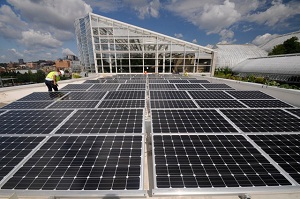Phipps Conservatory going for new standard in sustainability
 The new Center for Sustainable Landscapes at the Phipps Conservatory and Botanical Gardens in Pittsburgh will be completely powered by the sun and wind. But the gardens, which have a history of adopting sustainability initiatives, is going for a much higher standard of sustainability with the new center, the Living Future Institute’s Living Building Challenge.
The new Center for Sustainable Landscapes at the Phipps Conservatory and Botanical Gardens in Pittsburgh will be completely powered by the sun and wind. But the gardens, which have a history of adopting sustainability initiatives, is going for a much higher standard of sustainability with the new center, the Living Future Institute’s Living Building Challenge.
That’s in addition to the other levels of sustainability the company plans to achieve—the U.S Green Building Council’s LEED Platinum rating, its highest, and four-star certification under the Sustainable Sites Initiative for its landscape.
The site recently installed 125 kilowatts of SolarWorld photovoltaics, and it’s getting the rest of its energy needs from a geothermal heating and cooling system, and a vertical axis wind turbine, according to spokesperson Liz Fetchin.
“The PV and wind are designed to offset all the energy we need from the building itself,” said Phipps’ Executive Director Richard Piacentini. “We’re working toward meeting the Living Building Challenge. Any excess electricity produced will feed our internal campus.”
Piacentini has overseen the gardens’ shift to sustainability starting in 2003.
“I think the impetus for me was that I’ve always been concerned about the environment. It really happened when we did the first LEED building,” he said. “In the process of building it, we started looking at all our operations.”
From then on the institute has included sustainable features into all retrofits and future plans.
Such things include onsite composting, using local foods in its cafe, getting rid of bottled water and sodas in bottles and cans.
“We built the most energy efficient conservatory in the world,” Piacentini said. And they’ve done it on a nonprofit’s budget.
“I think most of [the projects] we’ve done have been pretty cost effective,” he said.
Still, a living building costs more than typical buildings, but its standards are much higher than LEED or other certifications, according to Piacentini.
“It’s kind of like LEED about 10 years ago,” he said.
When LEED first came out, people applied LEED standards to what had become traditional building materials, and it was costing significantly more. Now, more manufacturers are making efficient, sustainable products to help buildings meet LEED and Energy Star requirements. But not many companies are making equipment to meet the living buildings goals, making it more expensive.
The cost of the new center is $24 million, and the cost of the new, 24,350 square foot building is $9.5 million, Fetchin said.
“Living buildings—no one’s really done one before, and the manufacturers, architects and engineers haven’t done it yet. In a couple years, I think it will be a lot less expensive as people figure it out,” Piacentini said.
When the center is completed, slated for April 2012, it will likely be the only center in the world that has gone for all three sustainability awards.
Image courtesy of SolarWorld.



